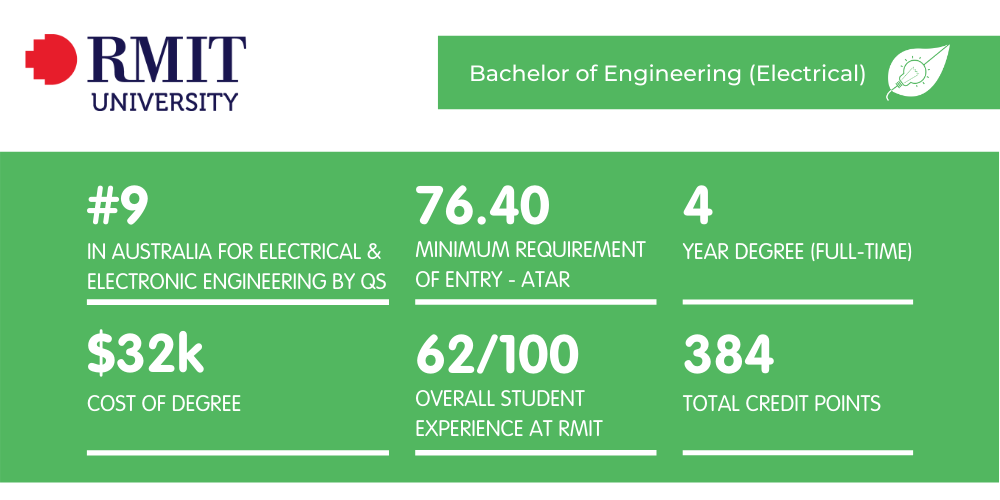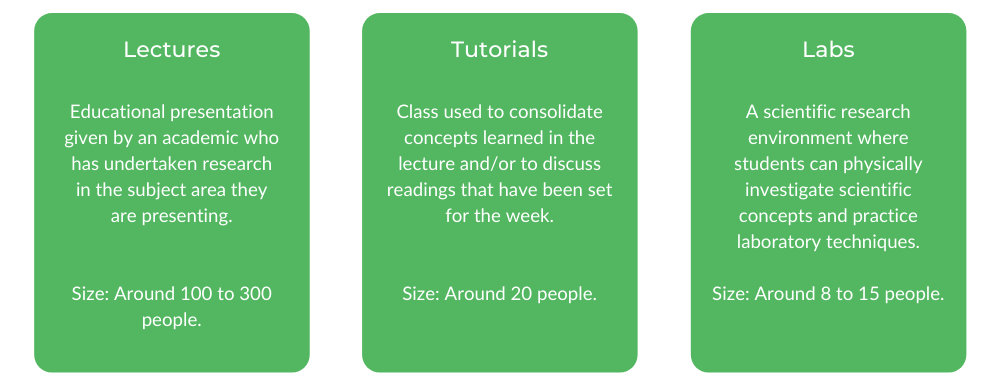Interested in studying a degree in Electrical Engineering at RMIT?
We’ve got everything you need to know about the degree in this article, including the outline, career pathways, majors and uni culture.
Let’s go!
What is Electrical Engineering at RMIT?
Core Units for this Degree
How to Get into Electrical Engineering at RMIT
What’s the Teaching Format?
What’s the Faculty and Culture Like?
What is a Bachelor of Engineering (Electrical Engineering) (Honours) at RMIT?
Electrical Engineering at RMIT allows you to learn about what goes into producing and distributing electricity, and put that theory into practice as an engineer. The degree teaches you how to design, develop and oversee the whole process of putting together electrical systems — from manufacturing, to installation, operation and then to maintenance.
The degree requires you to choose a specialist area, such as energy conversion, power systems or high-voltage equipment. You don’t have to make a proper decision until third year though!
Honours
Included in the degree is Honours, which allows you to build on your degree through project-based learning.
At RMIT, they require Electrical Engineering students to complete a capstone in their final year. This is usually a group project that students work on for their entire final year.
After choosing a topic from the list, groups spend the first semester planning and researching their first steps, as well as creating a brief timeline. The second semester is about putting that research into play, and actually building and experimenting on the design, before reporting and presenting on it.
During the capstone, students are also given a supervisor who checks in with them at regular intervals. Usually, this is someone from within the industry, so it’s a great chance to make connections and get relevant, up-to-date feedback.
Career Paths
As an electrical engineer, there are a lot of different industries you can go into! Check them out:
- Mining and resources
- Process control industries
- Electrified transportation
- Defence
- Automotive
- Power generation and distribution
- Industrial systems design
- Consumer product design
- Manufacturing
Core Units for this Degree
Each year, you are expected to complete 8 classes on a full-time load. In general, it’s 7 engineering units, and one elective unit, although it does depend on the year.
First Year
First year is dedicated to learning general engineering practices and mathematics and science. It’s a great chance for introductions to the type of content you’ll be doing in later years.
You also get the chance to engage in graphic design subjects and engineering software. You are expected to do 7 engineering courses and one elective course from any faculty.
This is great because it means you can expand your learning and engage in interests outside of your degree. The courses are:
- Introduction to Professional Engineering Practice
- Digital Fundamentals
- Introduction to Electrical and Electronic Engineering
- Engineering Mathematics
- Engineering Science
- Creative Engineering CAD (Computer Aided Design)
- Advanced Manufacturing and Mechatronics: What We Make it and How We Make It.
Second Year
Second year is structured much the same as the first — you must complete 7 engineering courses. However, the 8th course is an engineering elective, rather than a general elective.
The second year goes into further maths, and more on electricity and how that works with engineering, as well as more on computing and technology.
The compulsory courses are:
- Mathematics for ECE (Electrical and Computer Engineering)
- Electrical Engineering 1
- Electronics
- Introduction to Embedded Systems
- Engineering Design 2
- Signals and Systems 1
- Engineering Computing 1
The engineering electives you could choose from include: Communication Engineering 1, Network Fundamentals and Applications and Software Engineering Design.
Third Year
Students are required to complete 6 compulsory subjects, 1 engineering elective and 1 elective from any university faculty. In third year, the subjects get more specific, as well as introducing one subject on how engineers in particular should research.
The compulsory subjects include:
- Engineering Design 3
- Power System Analysis and Control
- Control Systems
- Electrical Plant
- Electrical Energy Conversion
- Research Methods for Engineers
The engineering electives are: Industrial Automation, Communication Engineering 1, Network Fundamentals and Applications, Switched Mode Power Supplies, Introduction to Electrical Building Design and Intelligent Systems. It’s from these electives that students can delve further into their specialisations, and enhance their knowledge of one particular area.
Fourth Year
The fourth and final year of Electrical Engineering at RMIT sees students studying 2 capstone units and choosing 6 subjects from a list of “Technical Option Courses” which further students’ specialisations. Some of these electives are really fun and niche, going into modern and futuristic areas like artificial intelligence.
The project completed in the capstone units can lead to many opportunities, as it is focussed on solving real-world problems. Extremely successful projects have the opportunity to present at EnGenius. The capstone units are: Engineering Capstone Project Part A and Engineering Capstone Project Part B.
There are a lot of different choices for Technical Option courses available. Some of these include:
- Foundations of Artificial Intelligence for STEM
- Industrial Automation
- Power Electronic Converters
- Renewable Electrical Energy Systems
- Electrical Transport Engineering
- Intelligent Systems
To see the full list of Technical Option courses, head to the handbook!
Work-Integrated Learning
Students take part in work-integrated learning during their capstone units. These can take place within industry settings, meaning students are gaining professional skills.
It’s also highly recommended that students take a work-integrated learning elective outside of their degree. This allows students to take on an internship, while still earning credit points towards their degree.
For more information about this subject, head here!
How to Get into Electrical Engineering at RMIT
The ATAR cut-off for this degree is 76.40. Information on specific pathways to studying Electrical Engineering at RMIT can be found here. More information about equity access to RMIT can be found here.
Adjustment Factors
Recent high school graduates have access to some adjustment factors, which might help them to get into the degree, through “aggregate points”.
If you receive a study score of 25 in Physics or Maths: Specialist Mathematics, you are eligible for 2 aggregate points. If you get a study score of 25 in Chemistry, you can receive 1 aggregate point.
RMIT also automatically gives applicants from low socio-economic status areas adjustment factors. These areas can be found by using the Australian Bureau of Statistics (ABS) Socio-Economic Index for Areas (SEIFA) Index of Education and Occupation.
Are there any prerequisites?
Prerequisites include a study score of at least 30 in English (EAL) or at least 25 in English other than EAL for units 3 and 4 and a study score of at least 20 in one of Maths: Mathematical Methods or Maths: Specialist Mathematics.
Scholarships
RMIT awards over 2, 000 scholarships each year and there are many available for engineering degrees.
For women in particular, there are opportunities to have your entire degree paid for by the university. For women studying Electrical Engineering specifically, the CitiPower and Powercor Women in Engineering Scholarship is an excellent chance for female students in second year or above to receive $10, 000 a year, for 3 years.
Eligibility for the scholarship requires a GPA of 2.5 or higher. More information about this scholarship can be found here!
What’s the Teaching Format?
RMIT teaches in semesters, with full-time students completing 4 subjects per semester. Electrical Engineering is taught through a mixture of lectures, tutorials and labs. This allows for constant, weekly consolidation of knowledge — through discussion and practical lab-work.
Class Structure
Lectures
Lectures focus on a different overarching topic each week and are led by an academic. There are usually a few hundred students in each lecture.
Tutorials
Tutorials take the content from lectures and put it into practice. They are led by a tutor, who leads the discussion and activities surrounding the lecture topic. There are usually 20 students in each tutorial.
Labs
Labs are where things get hands on! You can literally put the work learnt in lectures into practice.
These classes require a lot of group work, and are usually assessed as part of your attendance mark. There are usually 8 to 15 people in labs.
The workload can be a bit intense to detail with to begin with, but is manageable.
How much time do you spend in class?
Lectures are usually 2-3 hours long and tutorials are often about 1-2 hours. These occur weekly, while labs happen every second week and run for 2-3 hours.
In a full week with a lab, you would be on campus for 5-8 in the week for just one subject. If you were a full-time student doing 4 subjects a semester, this would work out to be 20-40 hours a week on campus.
What are the assessments like?
Assessments can be quite challenging, with the introduction of 12 hour, 24 hour and 72 hour take-home exams that can seem overwhelming at first.
For engineering, you’re largely expected to complete tests and exams, which is great if you’re not a fan of writing and academic reports. There will be some presentations, where you share with the class your plans and designs for electrical circuits and the like.
There is group work in just about every unit, which is a great way to make friends and seek out new perspectives. 4th year does not require a thesis, however, the capstone unit is quite heavy with work, as you design, build and present your own project.
Skills That You Develop
As part of RMIT Electrical Engineering, students learn specific, required technical skills that they will go on to use in the workplace. Things like coding, graphic design and soldering can all be useful in your career, and look great on your resume.
Other skills like team work and communication are gained through completing group assignments and assessments. Units like the capstone project rely largely on working efficiently in a group setting, which is modelled on how most engineering projects are structured in real life. This prepares students effectively for the workforce.
Professionalism can also be developed through work-integrated learning units, where you are encouraged to actually experience the industry through internships.
What’s the Faculty and Culture Like?
Engineering in general is quite a male-dominated faculty, wherever you go. Tahlya Torres, a fourth year student in Electrical Engineering, found it quite confronting at first, before realising the support from the other women around her.
She also recommended joining FIRE+, Females+ in RMIT Engineering, a club dedicated to women supporting other women within the faculty. They host fun events like games nights and baking nights, as well as talks like bystander intervention training and industry-based discussions and networking.
RMIT Engineers Australia Student Society (REASS)
Another club students may be interested in joining is the RMIT Engineers Australia Student Society (REASS). This is a student-run club, with members coming from across the entire engineering faculty. Membership is free for RMIT students and means access to information sessions, networking and social events.
EWB
Students can also take part in the Engineers Without Borders Challenge. This is a great way to gain practical engineering experience, while learning about how to use problem solving in engineering to help those less fortunate.
Students work in groups to help a particular disadvantaged community. They research the materials the community would have access to, and use them to design a tool.
So if you’re keen on making friends through clubs and societies, you’ve got a fair few options to turn to within the Engineering faculty!
Elizabeth Noonan is a Content Writer for Art of Smart and an undergraduate student at the University of Sydney. There, she studies a Bachelor of Arts/Advanced Studies, majoring in Media and Communications and French. Elizabeth is a huge movie buff and hopes to go into journalism after she finishes her degree.






